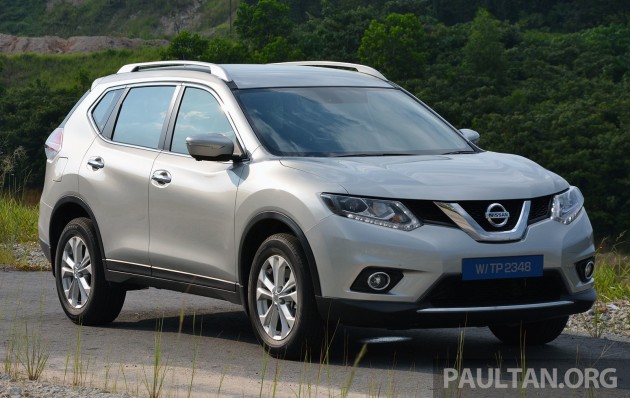
First there was one. The Honda CR-V has been “the people’s SUV” for close to two decades now, its de facto status in Malaysia cemented by archrival Toyota’s strange lack of interest in the segment. No, the truck-based Fortuner and Avanza-based Rush don’t count.
It’s no longer a free ride for Honda though, as the CR-V is facing a strong challenger in the Mazda CX-5. It may have started off as the alternative, but the CX-5 outnumbers the incumbent in trendier Klang Valley neighbourhoods these days, winning the visibility battle. I’m no cowboy, but I can tell you that carbuyers tend to stick with the herd – so many others cannot possibly be wrong, right?
Nissan knows the game because they’ve been in it before. One decade and two generations ago, when people still liked their SUVs rugged, the X-Trail was the CR-V’s sparring partner. The second-gen car, arriving here from Indonesia a few years late, used the same formula but didn’t catch on. It could have been that tastes have changed (or softened) while Nissan’s box stood still.
No sharp edges in sight now, as the third-generation X-Trail arrives in Malaysia just months after major markets Thailand and Indonesia, and in CKD form no less (it takes much longer to prep for local assembly as opposed to just ordering off the shelf). It looks throughly modern, is priced to match the two leading SUVs, and has some unique party tricks up its sleeve; so will it be a case of third time lucky for the X-Trail?

 Yes, you’re looking at a Nissan X-Trail, even if it looks nothing
like the previous two you knew. “No sharp edges” must have been the
design brief for the Hi-Cross concept from Frankfurt 2012, which the production T32 X-Trail faithfully replicates.
Yes, you’re looking at a Nissan X-Trail, even if it looks nothing
like the previous two you knew. “No sharp edges” must have been the
design brief for the Hi-Cross concept from Frankfurt 2012, which the production T32 X-Trail faithfully replicates. The current Nissan family face – as seen on the smaller Qashqai and defined by the mask-like grill-headlamp treatment and “bucket” chrome border for the logo – is coupled with boomerang daytime running lights for a visage that’s distinctive enough. Things flow along nicely on the wavy flanks before ending abruptly at a rear that resembles an old Toyota Harrier.
Derivative derrière aside, the new X-Trail is a pleasantly styled SUV, and it looks big in the metal compared to the CR-V. It is. At 4,640 mm, it’s 50 mm longer than the Honda, and equally wide at 1,820 mm. The Nissan stands 30 mm taller too, and its 2,705 mm wheelbase is a significant 85 mm lengthier than the CR-V’s. Needless to say, the X-Trail’s footprint easily shades the CX-5. Size and presence are important urban SUV ingredients, and the X-Trail impresses on both counts.
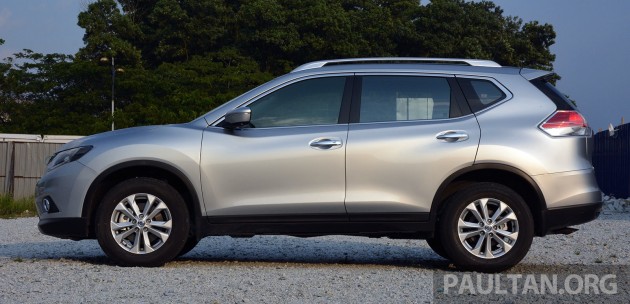
The X-Trail’s big body translates to generous cabin space, and the extra milimetres gave Nissan the opportunity to squeeze in a third row of seats. It’s more of a 5+2 than a full-fledged seven-seater SUV, but a second row that can slide and recline means that a compromise can be struck with the backbenchers.
The extra seats come in handy for the occasional outing with the extended family, or when going out for lunch with colleagues. You won’t get any meaningful luggage room with all three rows erect, and adults chucked in here will have their knees pointing to the roof (width is OK), so the third-row is better seen as a bonus.
You get a decent 550 litres of space with the rearmost seats folded 50:50 flat, but the operation isn’t one-touch, and neither is it for tumbling the 60:40 second-row, which introduces a 1,520 litre cave. The tonneau cover gets a neat underfloor compartment, but the cool partitioned tray from the second-gen is gone.
 The CR-V, and even my first-gen Mazda 6 Hatchback, has a lever on the boot wall
that can fold the rear seats in one motion, a real boon when plonking
in long items. To fold the X-Trail’s mid-row, you’ll need to open the
rear doors, or crawl into the hatch in an undignified manner, unless you
have Dhalsim’s arms. This is of course not an issue if you don’t often
haul very long items, as the X-Trail’s boot is big by any measure.
The CR-V, and even my first-gen Mazda 6 Hatchback, has a lever on the boot wall
that can fold the rear seats in one motion, a real boon when plonking
in long items. To fold the X-Trail’s mid-row, you’ll need to open the
rear doors, or crawl into the hatch in an undignified manner, unless you
have Dhalsim’s arms. This is of course not an issue if you don’t often
haul very long items, as the X-Trail’s boot is big by any measure. The regular rear seats are a good place to be in, with very generous legroom when pushed furthest back. Rear air-con vents and large square windows help the cause. Short of having a panoramic glass roof and light-coloured lower cabin, it’s as airy as it can get here. For an SUV, such an ambience is preferable to the dark cabins brought about by high waistlines and shallow windows in “sportier” designs.
Third-row aside, the X-Trail’s passenger space advantage over the CR-V isn’t as obvious as the bare wheelbase figures suggest, because the Honda makes mockery of WB length with good packaging. Everything else feels cramped in comparison, so do try them all out for size.
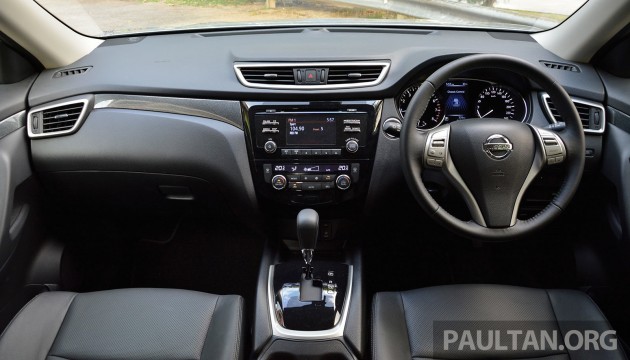
Now, let’s move up to the cockpit, without departing from the comfort-space theme. The X-Trail feels its width here, with an expansive dashboard and sizeable chairs. The latter deserves special mention – Zero-Gravity may sound corny but the front seats are soft without being saggy, something your back and bum will appreciate in evening-long traffic jams and cross-state jaunts alike. The 2.5 gets leather, but the fabric seats in the 2.0 are just as comfortable.
Nissan has been doing comfy seats in the same mould (not literally) for quite some time now – I remember thinking “Volvo-like” when driving the humble Latio years back – it was almost too much seat for such a small car! Colleagues who have driven the Teana are similarly chuffed about the D-segment sedan’s chairs.
The X-Trail’s dashboard also has a Teana feel about it; both share the same layout, if not design. Everything is laid out in a straightforward manner, with elements located where everyone expects them to be. It’s conventional, which may or may not be a bad thing, depending on what you’re looking for. Standard amenities include keyless entry with push start, dual-zone air con and steering buttons (audio + cruise control), which are all expected at this level.


 AVM combines images from front, side and back cameras; works on both factory and optional head units
What’s unique in the segment is Around View Monitor, which stitches
together live feed from the X-Trail’s front, side and back cameras to
assist in parking. The resulting top view is presented together with the
standard rear camera view on the smallish five-inch central screen.
Useful for a big SUV, we reckon, and it works on the optional Tan
Chong-fitted TCAT touch-screen navigation head unit, too.
AVM combines images from front, side and back cameras; works on both factory and optional head units
What’s unique in the segment is Around View Monitor, which stitches
together live feed from the X-Trail’s front, side and back cameras to
assist in parking. The resulting top view is presented together with the
standard rear camera view on the smallish five-inch central screen.
Useful for a big SUV, we reckon, and it works on the optional Tan
Chong-fitted TCAT touch-screen navigation head unit, too. Speaking of screens, the Advanced Drive Assist Display between the dials look impressive and is informative, with its sharp colour display and Active Chassis Control page. It provides some hi-tech glitter in an otherwise orthodox cabin.
Standard on both the 2.0L 2WD and 2.5L 4WD, Active Chassis Control is another unique selling point. The package includes Active Ride Control, Active Engine Brake and Active Trace Control functions. Active Ride Control manipulates engine torque as well as braking to moderate pitching motion on bumpy roads, while Active Engine Brake tells the CVT to add a degree of engine braking when cornering or coming to a stop.

 Active Trace Control automatically applies small amounts of braking
to the individual wheels during cornering to reduce understeer – the
system engages at any point in the corner, whether at entry, mid-corner
or exit. Both variants feature Hill Start Assist (for slopes above 5%)
but only the 2.5L 4WD gets Hill Descent Control (only in 4WD Lock mode,
speed locked between 4-15 km/h).
Active Trace Control automatically applies small amounts of braking
to the individual wheels during cornering to reduce understeer – the
system engages at any point in the corner, whether at entry, mid-corner
or exit. Both variants feature Hill Start Assist (for slopes above 5%)
but only the 2.5L 4WD gets Hill Descent Control (only in 4WD Lock mode,
speed locked between 4-15 km/h).Nissan’s All Mode Intelligent 4X4-i offers three drive modes – two-wheel drive, Auto (which automatically changes torque distribution between front and rear wheels when driving on paved or slippery roads) and 4WD Lock (50:50) for permanent four-wheel drive. Modes are selectable via a knob on the centre console. The 2WD car gets an extra cubby hole in its place.
How’s the X-Trail like to drive? Like a Nissan, and we mean that as a compliment. Over the years we’ve become accustomed to the brand’s smooth, gliding style thanks to good noise suppression and the firm’s Xtronic CVT gearbox, and we’re please to see the new X-Trail follow this template.
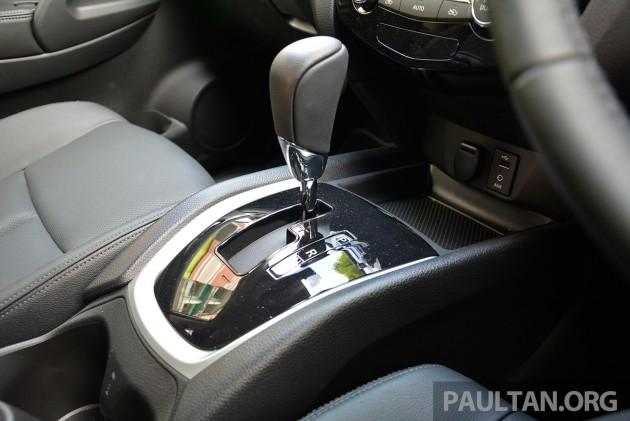
Like the previous-gen X-Trail and both previous and current Sylphys, there’s an effortless quality about how the car picks up speed and maintains momentum – you’ll definitely feel like you’re working harder in a CR-V, which has a healthy appetite for revs.
However, the X-Trail 2.5 was pretty vocal at low revs, which is pretty much where you’re at in the urban crawl. It could be overeager throttle response or inadequate insulation, but the gruff engine note is unexpected. It’s not that the X-Trail is unrefined vis-à-vis rivals, just slightly short of the serenity we know Nissan can achieve.
Strange one, this, especially when the gruffness is not so noticeable in the 2.0, an observation also noted by my InfoKereta.com colleague Izwaashura Sadali on our drive from Shah Alam to Damai Laut and back.
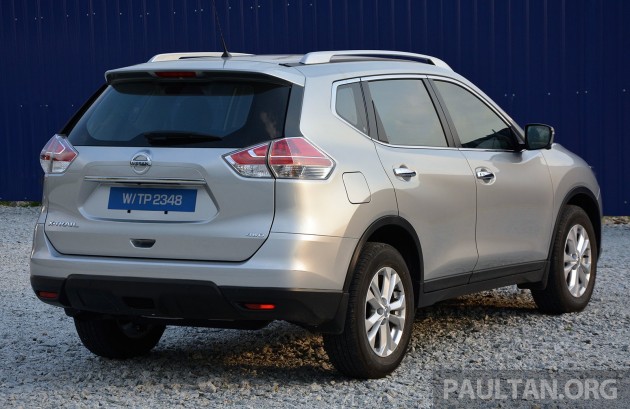
So, not for the first time, this writer is preferring the smaller engine in the range. Not only is the MR20DD’s response more measured, there’s enough grunt to not feel overwhelmed by the X-Trail considerable size. Sure, the 2.5’s power advantage (171 PS and 233 Nm) is palpable and the QR25DE-k2’s acceleration impressive, but the 144 PS/200 Nm 2.0L hits the sweet spot for us, if 4WD is not necessary.
A quick note on the Xtronic CVT, which gets a seven-speed manual mode here. That’s an on-paper advantage over the Sylphy and Teana, but we never once felt the need to DIY, which is a mark of a good automatic. The ‘box is typically smooth, and this latest-gen Xtronic doles out torque converter auto-mimicking faux upshifts to make CVT newbies feel at home.
The X-Trail is a big, tall car and it feels its size when you manhandle it; the lean and weight shift will remind you so if you throw it around corners. Drive it in a more progressive fashion, as you should in a big family wagon, and you’ll find well-weighted electric steering, which remains steady and true in high-speed cruising. The latter shouldn’t be taken for granted, as it reduces fatigue and makes long drives more pleasant.

 While it’s not an engaging drive, the X-Trail is dynamically
competent enough to avoid being ponderous – we have no complaints on how
it steers, brakes and grip. Ride comfort passes muster too, with Active
Ride Control taming bounce in this relatively softly sprung SUV. Would
have preferred a more ‘invincible, smother away everything’ low speed
ride – given the high-profile tyres and my faint memory of the
previous-gen car – but it’s good enough.
While it’s not an engaging drive, the X-Trail is dynamically
competent enough to avoid being ponderous – we have no complaints on how
it steers, brakes and grip. Ride comfort passes muster too, with Active
Ride Control taming bounce in this relatively softly sprung SUV. Would
have preferred a more ‘invincible, smother away everything’ low speed
ride – given the high-profile tyres and my faint memory of the
previous-gen car – but it’s good enough. All in all, the X-Trail is an easy going, easy driving car – its smooth and comfy disposition fitting the brief as a family SUV to a tee. Its unique selling points are practical in nature (two extra seats, 360-degree view park assist) and not gimmicky, with airbag count (two) being the only hole in its armour. It’s a likeable SUV, this third-generation X-Trail, and we won’t bet against Nissan being third time lucky.
